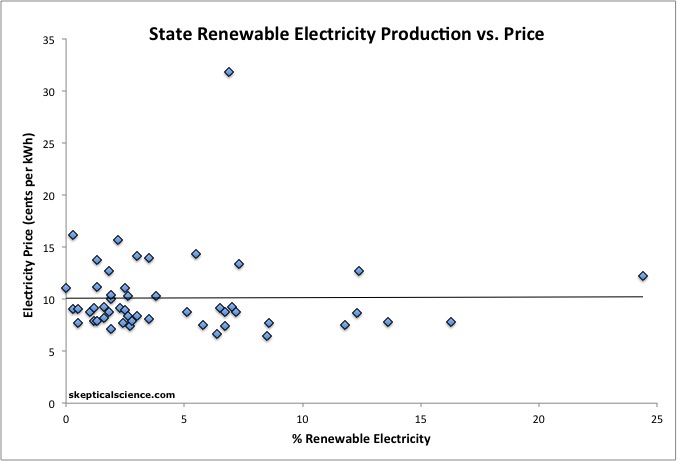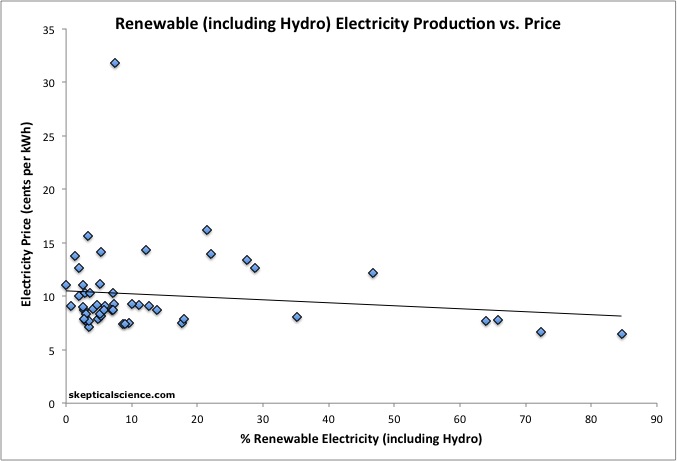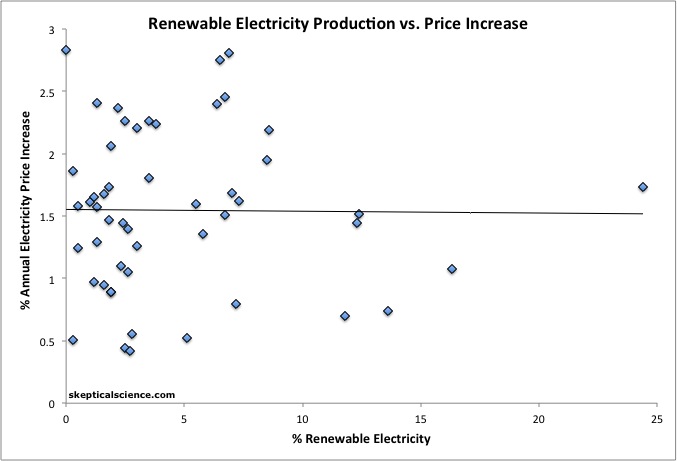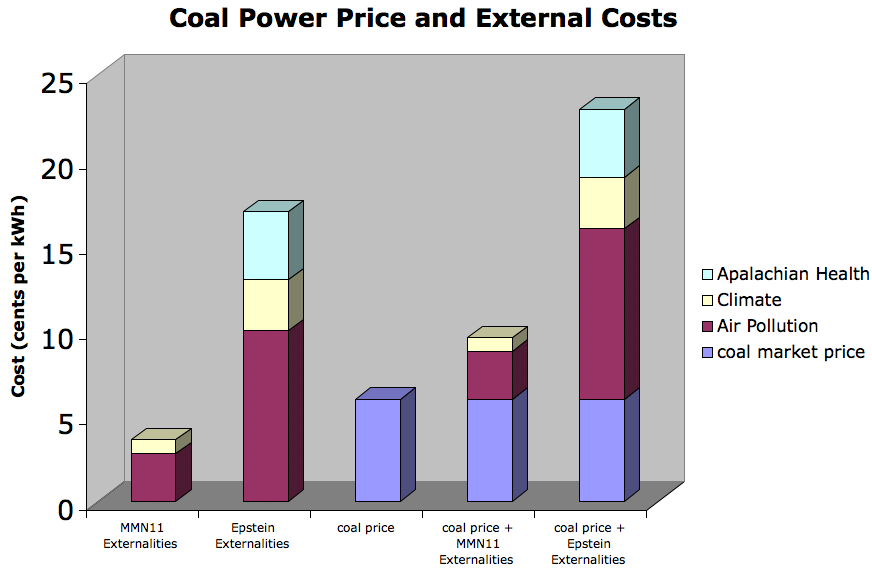Putting an End to the Myth that Renewable Energy is too Expensive
Posted on 3 January 2013 by dana1981
The Washington Post recently published an excellent piece of investigative journalism in which they found that the Heartland Institute has teamed up with the American Legislative Exchange Council (ALEC) in an effort to reverse state renewable energy mandates across the USA. ALEC is a highly controversial organization, essentially comprised of corporations which draft up legislation favorable to their interests, and then pass it along to legislators who will introduce and attempt to implement their bills in state legislatures and US Congress.
The Washington Post reports that ALEC has drafted the Electricity Freedom Act, which would repeal state renewable electricity standards (RESs), which require that a given state meet a certain percentage of its electricity demand with renewable sources by a certain date. For example, California has an RES to supply 33% of its electricity demand with renewables by 2020, and overall 29 states (plus the District of Columbia) have RESs in the USA. A further 7 states have non-mandatory renewable electricity goals (Figure 1).
Figure 1: States with Renewable Electricity Standards and Goals. Source: US Energy Information Administration (EIA).
The Heartland Institute defended the group's efforts to repeal state RESs, calling them "essentially a tax on consumers of electricity" and claiming:
"alternative energy, renewable energy, is more expensive than conventional energy."
In short, the Heartland/ALEC argument is that mandating that electricity comes from renewable sources will raise prices for consumers, and that we should therefore not implement these standards.
There are of course many benefits to implementing renewable energy which this argument neglects, primarily involving reduced pollution — both of traditional pollutants and their human health effects, and greenhouse gases and their climate impacts. But before we address these important neglected points, is it true that deploying renewable energy technologies raises electricity prices? Let's see what the data say.
Renewable Energy Implementation vs. Electricity Prices
To test the Heartland/ALEC claim, we've obtained state renewable electricity generation and electricity price data and from the US Energy Information Administration (EIA). First let's just ask the simplest question — what is the correlation between the percentage of a state's renewable electricity generation and its electricity prices? As Figure 2 shows, the two variables are essentially uncorrelated (correlation of 0.007, to be precise), meaning that a higher percentage of renewable energy generation has not translated to higher electricity prices.
Figure 2: State renewable (excluding hydroelectricity) electricity percentage of total electricity generation vs. electricity price (blue diamonds) with a linear trend (black line). Data from EIA (here and here).
In fact when we include hydroelectricity production in the renewable category, electricity prices actually decline slightly with higher renewable production (Figure 3).
Figure 3: State renewable (including hydroelectricity) electricity percentage of total electricity generation vs. electricity price (blue diamonds) with a linear trend (black line). Data from EIA (here and here).
However, perhaps the states which have implemented more renewable energy started off with lower electricity prices, and perhaps deploying these supposedly more costly energy sources has indeed caused those prices to rise faster than states which continue to rely on fossil fuels.
Alas no, Heartland and ALEC are not saved by this potential nuance. Figure 4 illustrates that there is virtually no correlation (correlation of -0.01) between a state's renewable electricity contribution and its electricity price increase between 1990 and 2011.
Figure 4: State renewable (excluding hydroelectricity) electricity percentage of total electricity generation vs. the percent annual increase in electricity price 1990—2011 (blue diamonds) with a linear trend (black line). Data from EIA (here and here).
Therefore, deploying renewable energy sources has not caused electricity prices to increase in the United States.
What About Subsidies?
Heartland and ALEC would undoubtedly argue that electricity prices have not risen alongside renewable energy deployment due to government subsidies. There may be a sliver of truth to this argument.
- On the one hand, according to an Environmental Law Institute report, in the USA between 2002 and 2008, fossil fuels received approximately 2.5 times more subsidies than renewable energy ($72 billion vs. $29 billion). This also includes transportation fuels, and over half of the renewable subsidies went to corn ethanol, which is not used for electricity production.
- On the other hand, this represents a much larger renewable energy subsidization per unit of electricity produced, since fossil fuels account for a much larger fraction of the overall USA electricity mix (70% vs. 4.1%, respectively, or 70% vs. 10.4% if hydroelectricity is included in the renewable category).
- However, fossil fuels have been receiving government subsidies for over a century, and therefore have received much larger overall government subsidies than renewable sources.
So while renewable energy sources appear to be receiving more government subisides per unit of energy produced than fossil fuels, fossil fuels are receiving larger total subsidies, and have historically received far more subsidies than renewables. And then there are the hidden subsidies.
Carbon — The Huge, Overlooked Fossil Fuel Subsidy
Carbon emissions may reasonably be considered a subsidy because they impose various costs on society via climate change (on agricultural productivity, property damage, human health, etc.), but since most countries don't yet put a price on carbon emissions, these costs are not reflected in the fossil fuel market price. Rather than fossil fuel producers and consumers paying these costs, society as a whole picks up the tab. Therefore, fossil fuel prices are kept artificially low (Figure 5), which is generally the purpose of subsidies.
Figure 5: Average US coal electricity price vs. Muller, Mendelsohn, and Nordhaus (2011) and Epstein et al. (2011) best estimate coal external costs.
The "social cost of carbon" (an estimate of the direct effects of carbon emissions on the economy) remains a highly uncertain cost, but according to a recent study by Johnson and Hope (2012), is somewhere in the ballpark of $100 per ton of CO2 emitted, which is similar to the highest value used in Epstein et al. (2011). Accounting for this cost would add approximately 9 cents per kilowatt-hour (kWh) to the price of coal-generated electricity (which would more than double its market price), or approximately 4 cents per kWh to natural gas. On top of that, there are the other external adverse health effects from coal illustrated in Figure 5, which are not reflected in the market price.
In reality, coal in particular is a very expensive energy source. Unfortunately its true cost is not accurately reflected in its market price, which allows groups like Hearland and ALEC to pretend that it's cheap and that transitioning to renewable energy will be too expensive. In reality, the opposite is true. Continuing to rely on coal is an extremely expensive proposition.
Renewable Energy is Not Expensive
To summarize,
- States with a larger proportion of renewable electricity generation do not have detectably higher electric rates.
- Deploying renewable energy sources has not caused electricity prices to increase in those states any faster than in states which continue to rely on fossil fuels.
- Although renewable sources receive larger direct government subsidies per unit of electricity generation, fossil fuels receive larger net subsidies, and have received far higher total historical subsidies.
- When including indirect subsidies such as the social cost of carbon via climate change, fossil fuels are far more heavily subsidized than renewable energy.
- Therefore, transitioning to renewable energy sources, including with renewable electricity standards, has not caused significant electricity rate increases, and overall will likely save money as compared to continuing to rely on fossil fuels, particularly expensive coal.
Note: this post has been incorporated into the rebuttal to the the myth that renewable energy is too expensive































 Arguments
Arguments



























 0
0  0
0






Comments